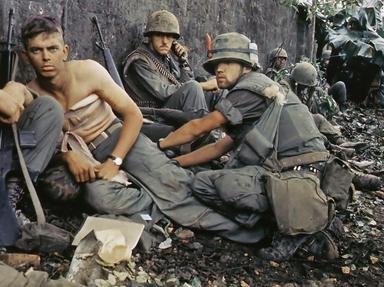Quiz Answer Key and Fun Facts
1. Who commanded the 9th Marine Forces that landed on the beaches of Vietnam in 1965?
2. What did MACV stand for?
3. Where did the Marines land in Vietnam on 8 March 1965?
4. On 13 May 1968 the 141st NVA regiment attacked a FSB (Fire Support Base) in battalion strength. What was the name of the firebase?
5. Which of these ships, that served in the Vietnam War, was NOT an American ship?
6. In 1960 US Special Forces trained the Vietnamese later resulting in a Vietnamese Ranger Unit. What was the nickname of this elite unit?
7. Ho Thi Que fought with the South Vietnamese 44th Ranger Battalion. Which of these statements are INCORRECT?
8. What was Thich Quang Duc's "claim to fame" in 1963?
9. What was the FIRST Asian nation to contribute troops to the Vietnam War effort (excluding, obviously, South Vietnam)?
10. The section of highway between Quang Tri and Tan My was known as what?
11. What was the code name for the withdrawal of US forces in Vietnam?
12. Psychological Warfare Operations were conducted during the Vietnam War. What was the acronym used to describe the units and operations?
13. Who was assassinated on 5 June, 1968?
14. We all know that Richard Nixon was the President from 1969 to 1974 during the Vietnam War. But what was his middle name?
15. A number of Pulitzer Prizes were awarded for photographs taken during the Vietnam War. Which of these was NOT a Pulitzer Prize winning photograph?
Source: Author
Lssah
This quiz was reviewed by FunTrivia editor
bloomsby before going online.
Any errors found in FunTrivia content are routinely corrected through our feedback system.

